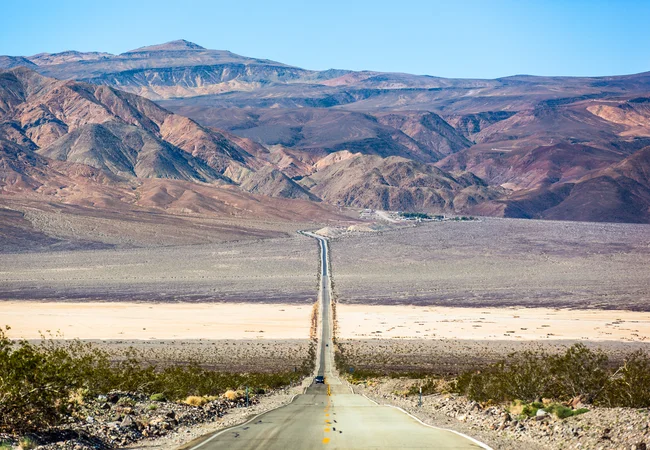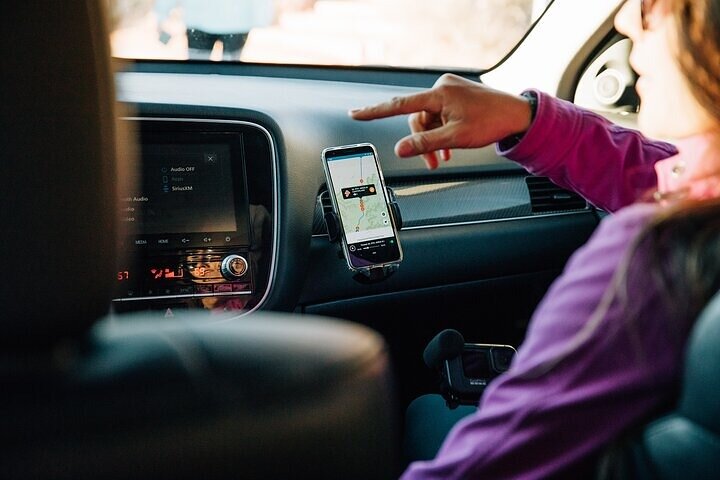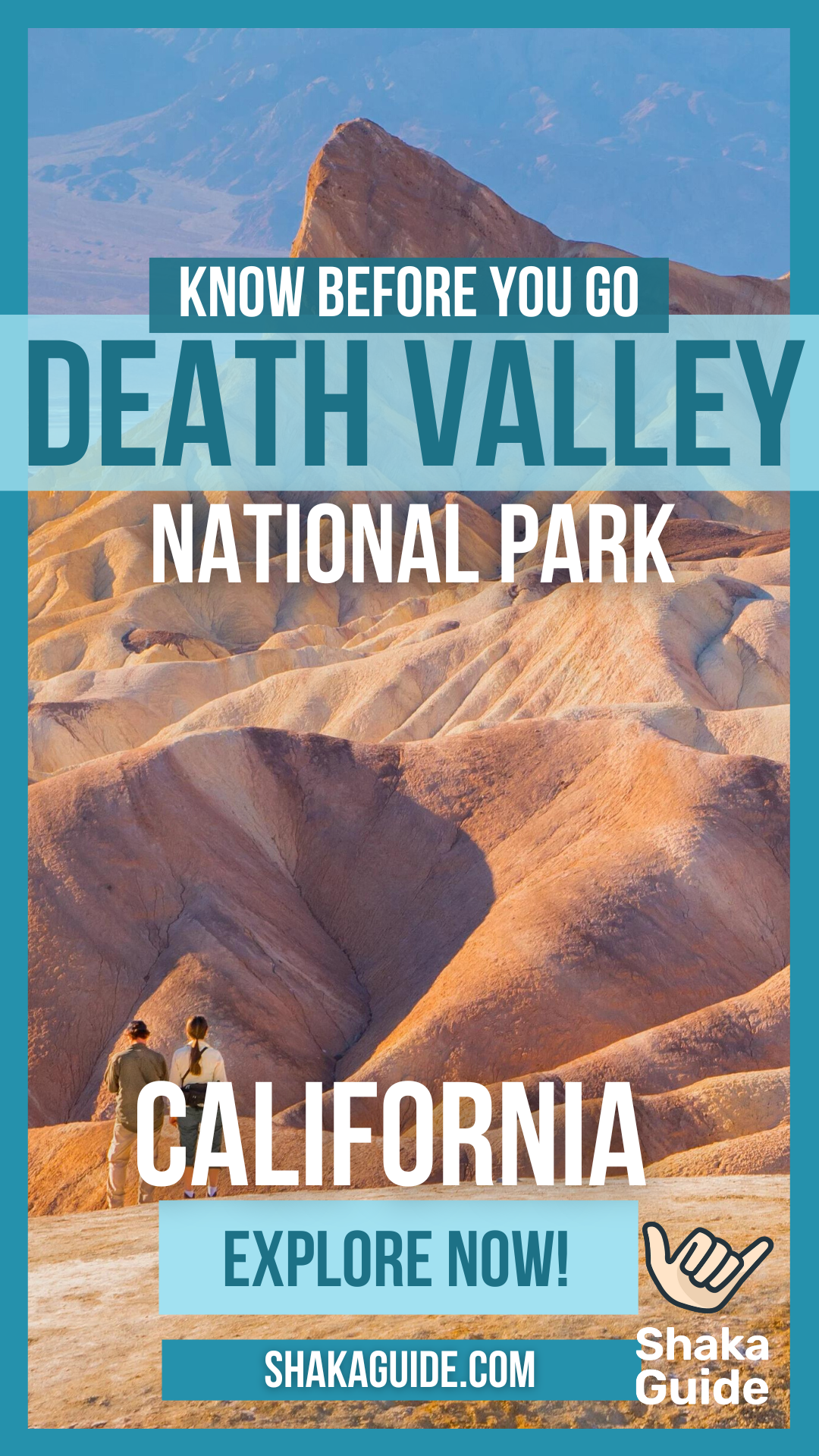Death Valley is one of America’s most evocative national parks, with desolate desert landscapes, dramatic mountain ranges, and of course, the lowest point in North America. Let Shaka Guide lead the way!
 Shutterstock Image
Shutterstock Image
We take you to many of the park’s most fascinating and awe-inspiring places.
With 19 stops and 140 audio tracks, we cover popular attractions like the:
- Badwater Basin salt flats
- Dante’s View Overlook
- Mesquite Flat Sand Dunes
Because of the park’s harsh environment, not to mention its vast size, there are a few things you need to know before you go.
Keep reading to make the most out of your visit.
Start Planning

- Our tour starts from two different entrances, the east entrance by Death Valley Junction, and the West Entrance near Panamint Springs.
- The fee to enter Death Valley National Park is $30 per vehicle, good for 7 days. There’s no gate controlling entry to the park, so you’ll stop by an entrance station or visitor center to pay for the pass.
- The park is open 24/7, so you can start or end your tour at any time. Plan to stay out late for some spectacular stargazing!
- Cell service is spotty and Wi-Fi is almost non-existent in the park, so download the tour before you go!
- There are two gas stations along the tour route: one at Furnace Creek and the other at Stovepipe Wells. Gas is cheaper outside the park.
- Places to purchase supplies inside the park are few and far between. Purchase water and snacks somewhere in town before entering the park.
What to Expect
To Get An Early Start
What’s the best way to get the most out of your day? Get an early start!
Try to reach an entrance gate no later than 9 a.m. (or even 8 a.m.) to beat the heat and fill the day with sightseeing.
To Do A Lot Of Driving
Death Valley National Park is the largest national park in the lower 48 states.
Our tour takes most of the day, and we still don’t hit everything! Some parts of the tour require lots of driving in between stops.
Not to worry: we’ve got stories, important logistical tidbits, and music to keep you occupied.
To Drink a Lot of Water
It’s not called Death Valley for nothing! Even in cooler months, this is still a very dry desert.
To be on the safe side, bring a gallon of water per person. Especially if you plan on doing any hiking.
To Pay A Lot for Food and Gasoline
This park is pretty remote, so gas and food are at a premium here.
If you can, buy supplies and gas in town before heading into the park.
Stop by a grocery store to pick up picnic food rather than pay for a meal in the park.
Otherwise, prepare to spend a lot of money. Generally speaking, prices for gas and food are better at Stovepipe Wells than at Furnace Creek.
To Enjoy That ‘Wow’ Factor
If you’ve never visited Death Valley, how do you imagine the park’s appearance?
You may know it’s home to Badwater Basin, the lowest point in North America, but you may be surprised at the vast scale of this valley, with daunting mountain ranges looming over salt pans and basins.
And with no trees in the way, you can see a long, long way. So enjoy this epic landscape!
To Experience Different Temperatures
We have nearly 6,000 feet of elevation change on our Death Valley tour.
Dante’s View is consistently 20-25 degrees Fahrenheit cooler than Badwater Basin below.
That relief may be welcome in the hot months, but during the winter, that could mean needing a coat!
To Learn
Death Valley is far from empty. It’s full of stories, and we do our best to share the best ones.
As you drive through the park, you’ll learn about the park’s mining history, geology, and human presence.
You’ll also learn about a surprising number of pop culture references, including some blockbuster filming locations.
You’ll leave the park as an expert on everything Death Valley.
Budgeting
While on the tour, the only things you need to budget for are food, souvenirs, fuel, and the park’s entry fee.
Of course, you should also take into consideration any supplies you may need to purchase before starting the tour, like sunscreen and snacks.
- $30 entry fee per vehicle, good for 7 days.
- $15-40 per person per meal. And forget to buy jugs of water!
- Souvenirs at the park’s general stores.
Safety Information
- Bring snacks and plenty of water, especially if you go hiking.
- Avoid hiking alone.
- Avoid hiking or driving in canyons in wet weather, or if a storm is imminent.
- If you have car trouble, remain by your car.
- Call (760) 786-3200 for current road conditions.
- On the extremely unlikely chance you encounter a mountain lion while hiking in the mountains, make a lot of noise, pick up small children, and don’t run away. Maintain eye contact as you slowly back away and give the animal space. In the extremely unlikely event that the animal attacks, fight back.
Start Packing!
Here’s our packing list. What you take depends on what you plan to do on the tour.
- Phone charger/mount (very important!)
- Sneakers
- Hiking clothes
- Hiking shoes
- Jacket for higher elevations
- Hat/sunglasses
- Sunscreen
- Water
- Canteen/ refillable water bottle
- Snacks
- Credit card
Leave No Trace
Here at Shaka Guide, we promote ways we can preserve special places, like our national parks, for future generations.
Please pick up your trash, leave plant and animal life as you find it, and stick to marked trails.
In this way, generations to come can enjoy Death Valley National Park.
We hope that we’ve given you all the information you need to make the most of your day. Your vacation is extremely important to us so if you have any questions feel free to reach out at aloha@shakaguide.com.
For more detailed information to help you plan, check out our Death Valley National Park Itinerary!
Like this article? Share it on Pinterest!

RELATED ARTICLES:
The Best Things To Do In Death Valley National Park
How to Get From Las Vegas to Death Valley
Should You Visit Death Valley in Winter?
The Ultimate Red Rock Canyon Travel Guide
The Ultimate Hoover Dam Travel Guide
The Ultimate Grand Canyon South Rim Guide
The Ultimate Zion National Park Guide
Know Before You Go - Yosemite National Park

